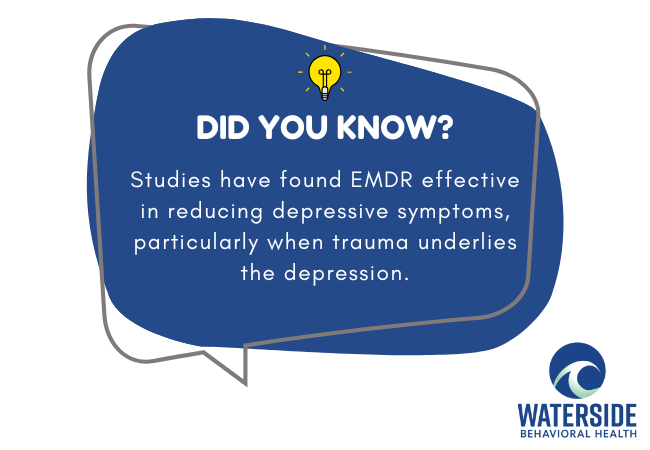Trauma can deeply impact an individual’s emotional, mental, and physical well-being, often leaving lasting scars that disrupt daily functioning and overall quality of life. For many people, traditional talk therapies provide some relief but may not be sufficient to fully process and resolve the intense effects of traumatic experiences. One therapeutic approach that has gained significant recognition for its effectiveness in trauma recovery is Eye Movement Desensitization and Reprocessing, or EMDR therapy.
Understanding how EMDR works and its unique role in trauma treatment can open new doors for healing and empowerment. At Waterside Behavioral Health, we are committed to offering evidence-based therapies that facilitate meaningful recovery. Our team helps individuals navigate their trauma journey with compassion and expertise, incorporating innovative modalities such as EMDR to promote healing on a deeper level.
What Is EMDR Therapy?
Trauma can leave deep imprints on the mind, making it difficult for individuals to feel safe, grounded, or emotionally balanced even years after the initial event. While many therapeutic approaches focus on talking through trauma, Eye Movement Desensitization and Reprocessing (EMDR) offers a different route—one that taps into the brain’s natural ability to heal itself.
A structured and evidence-based psychotherapy approach, EMDR Therapy in Massachusetts has evolved significantly since its inception by psychologist Francine Shapiro in the late 1980s. Initially used to treat post-traumatic stress disorder (PTSD), its reach now includes various trauma-related disorders, anxiety, and emotional dysregulation.
Unlike traditional talk therapies, EMDR utilizes bilateral stimulation—such as guided eye movements, audio tones, or tactile pulses—to engage both hemispheres of the brain. This process helps individuals reprocess distressing memories so they are no longer psychologically disruptive. Rather than simply talking about traumatic events, EMDR enables clients to reframe those experiences and significantly reduce their emotional intensity.
By reprocessing painful memories in a safe, controlled environment, clients are better able to integrate those experiences into their broader life story, allowing for greater emotional clarity, self-awareness, and resilience.
How Trauma Affects the Brain
Trauma impacts the brain in profound ways. When an individual experiences overwhelming stress or danger, the brain’s survival mechanisms trigger a fight, flight, or freeze response. During this state, certain parts of the brain, like the amygdala (responsible for emotional reactions), become overactive, while the prefrontal cortex (responsible for reasoning and decision-making) may become underactive.
This imbalance can cause traumatic memories to become “stuck,” meaning they are not fully processed or integrated into normal memory networks. As a result, these memories may replay involuntarily as flashbacks, nightmares, or intrusive thoughts. This persistent hyperarousal disrupts daily life and can lead to conditions such as PTSD, anxiety disorders, depression, and other mental health challenges.
EMDR therapy addresses this neurological disruption by activating the brain’s natural healing processes, allowing these “stuck” memories to be reprocessed and integrated. The result is often a significant reduction in distress and an improvement in emotional regulation.
The EMDR Therapy Process
EMDR therapy typically unfolds in eight phases, each designed to ensure safety, stabilization, and gradual progress toward trauma resolution. These phases include:
-
History and Treatment Planning: The therapist gathers detailed information about the client’s trauma history, symptoms, and goals. This phase ensures that therapy is tailored to the individual’s needs.
-
Preparation: Clients learn grounding and coping techniques to manage distress that may arise during sessions.
-
Assessment: Specific traumatic memories are identified and broken down into their sensory, emotional, and cognitive components.
-
Desensitization: The core phase where bilateral stimulation (usually eye movements) occurs while the client focuses on the traumatic memory. The brain begins to reprocess and reduce the intensity of the memory.
-
Installation: Positive beliefs and cognitive shifts are strengthened to replace negative thoughts associated with trauma.
-
Body Scan: The client is guided to notice any residual physical tension related to the trauma and process it.
-
Closure: Each session ends with stabilization techniques to ensure the client leaves feeling safe and grounded.
-
Reevaluation: The therapist assesses progress and determines the focus for future sessions.
The number of sessions varies depending on the complexity and severity of trauma but many clients experience meaningful relief within a relatively short timeframe compared to traditional therapies.

Benefits of EMDR in Trauma Recovery
EMDR therapy offers multiple benefits that make it a compelling choice for trauma treatment:
-
Rapid Reduction of Symptoms: Many clients report significant relief from PTSD symptoms, anxiety, and depression after just a few sessions.
-
Non-Invasive: EMDR does not require prolonged verbal recounting of trauma, which can sometimes retraumatize individuals.
-
Addresses Deep-Seated Memories: It helps process memories that may be unconscious or difficult to access through talk therapy alone.
-
Empowers Clients: By fostering healthier beliefs and coping mechanisms, EMDR strengthens self-esteem and resilience.
-
Can Complement Other Therapies: EMDR integrates well with other evidence-based treatments, such as cognitive-behavioral approaches.
EMDR Therapy in a Broader Treatment Context
At Waterside Behavioral Health, we recognize that trauma recovery is rarely a one-size-fits-all process. EMDR is often part of a comprehensive plan that includes supportive therapies and structured programs. For many individuals, engaging in Partial Hospitalization Programs in Massachusetts or other levels of care provides the stability, routine, and intensive support needed to maximize the benefits of EMDR therapy.
Partial hospitalization programs offer a balanced approach between inpatient care and outpatient therapy, allowing clients to receive daily therapeutic support while maintaining connections to their home life. This structure is particularly effective for those processing complex trauma, as it provides an environment that fosters safety and continuity of care.
Trauma Therapy Beyond EMDR
While EMDR has distinct advantages, trauma therapy as a whole involves a range of modalities designed to meet diverse client needs. Approaches such as trauma-focused cognitive-behavioral therapy (CBT), dialectical behavior therapy (DBT), and somatic experiencing address different facets of trauma response, including emotional regulation, interpersonal relationships, and body awareness.
Waterside Behavioral Health specializes in integrating multiple trauma therapies tailored to each individual’s unique history and goals. This personalized, multifaceted approach enhances the chances of sustained healing and recovery.
Why Choose Waterside Behavioral Health?
Choosing the right facility for trauma recovery is critical to achieving lasting results. Waterside Behavioral Health stands out as a leader in providing compassionate, expert care tailored to the complexities of trauma. Our team of licensed clinicians is trained extensively in EMDR therapy and other trauma-informed approaches, ensuring clients receive the highest standard of treatment.
Our facility is designed to promote a safe, calming atmosphere where clients can explore their healing journey with dignity and respect. We emphasize a collaborative therapeutic relationship, encouraging clients to take an active role in their recovery process.
Moreover, as a dedicated Mental Health Treatment Center in Massachusetts, we offer a continuum of care options including intensive outpatient services, partial hospitalization, and individualized therapy. This range allows clients to find the right level of support and transition smoothly through each phase of recovery.
At Waterside, we also prioritize education and empowerment. We work with clients and their families to understand trauma’s impact and develop tools to maintain wellness long after formal treatment ends. Our goal is not just symptom reduction but transformation — helping clients reclaim their lives and build hopeful futures.
Conclusion
EMDR therapy is a powerful, scientifically supported tool in the treatment of trauma and its related mental health challenges. By helping the brain reprocess traumatic memories, EMDR enables individuals to move past the debilitating effects of trauma and regain control over their emotional well-being.
When combined with structured programs like Partial Hospitalization Programs in Massachusetts and delivered by compassionate professionals in a trusted setting like Waterside Behavioral Health, EMDR therapy offers a pathway to profound healing and recovery.
If you or a loved one is struggling with the aftermath of trauma, reach out to Waterside Behavioral Health today. Our expert team is ready to support you on your journey to healing. Call us at (774) 619-7750 to learn more about how our trauma therapy services can make a difference.
Frequently Asked Questions (FAQs)
What makes EMDR therapy different from traditional talk therapy?
EMDR therapy uses bilateral stimulation, such as eye movements or auditory tones, to help the brain process traumatic memories. Unlike traditional talk therapy, which focuses on verbal processing, EMDR targets the brain’s natural healing pathways to reframe distressing experiences.
How long does EMDR therapy usually take?
The duration of EMDR therapy varies depending on the complexity of the trauma and the individual’s response to treatment. Some people see results in a few sessions, while others may require several months of consistent work with a licensed therapist.
Can EMDR therapy be combined with other forms of treatment?
Yes. EMDR is often integrated into comprehensive treatment plans that include other therapeutic approaches such as cognitive-behavioral therapy, medication management, or group therapy. This combination helps address various aspects of trauma and mental health.
Is EMDR therapy suitable for all types of trauma?
EMDR is effective for a wide range of trauma, from single-incident events like car accidents to complex trauma involving long-term abuse or neglect. A licensed clinician will determine whether EMDR is appropriate based on the client’s history and symptoms.
Do I need a diagnosis of PTSD to start EMDR therapy?
No. While EMDR was initially designed for PTSD, it is now widely used to treat anxiety, depression, panic disorders, and more. Anyone struggling with distressing memories or emotional dysregulation may benefit from EMDR therapy, even without a formal PTSD diagnosis.




